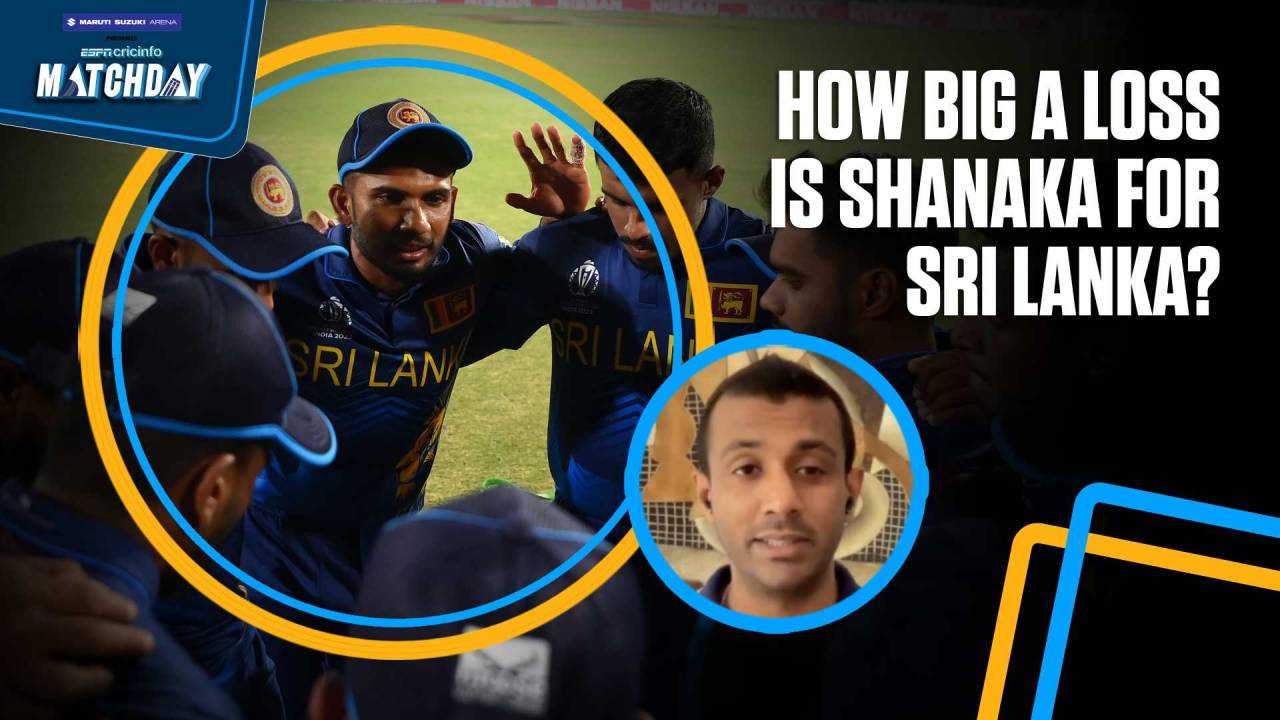Sri Lanka bowling fire doused by flat Indian pitches
They had wanted to practice on such pitches back home in the lead-up to the World Cup, but their complaints went unheard
Andrew Fidel Fernando
15-Oct-2023
Between June 4 and September 12 this year (both days inclusive) Sri Lanka played 14 ODIs, and bowled the opposition out in each one. The previous world record for bowling oppositions out in consecutive matches was 10, by the Australia side of the late aughts.
If you are unaware of the caveats that attach themselves to this extraordinary wicket-taking run, here they are:
- Eight of these matches came in the World Cup Qualifier, and hence against a significantly worse quality of opposition than in the World Cup proper.
- Of the remaining six matches, five came at home.
- The one that didn't come at home was against Afghanistan in Lahore, when they needed to chase 292 in a little over 37 overs, and almost succeeded.
But for all those caveats, 14 matches is a monster stretch for any attack. Right through that sequence - at the end of which even India were dismissed - Sri Lanka's bowling had a dynamism to it. There were left and right-arm quicks getting new-ball swing (Dilshan Madushanka, Lahiru Kumara, and Kasun Rajitha), a legbreak bowler with a killer googly in Wanindu Hasaranga (who didn't play in the Asia Cup, but topped the wicket charts in the Qualifier), a round-arm speed merchant (Matheesha Pathirana), and Maheesh Theekshana's finger-flicked mystery. If we were being generous, there was even a pale shadow here of the variety that comprised Sri Lanka's greatest white ball attack, circa 2007 to 2014 (Lasith Malinga, Nuwan Kulasekara, Ajantha Mendis, a young Angelo Mathews - Muttiah Muralitharan is incomparable, of course).
In the first two matches of this World Cup, however, Sri Lanka have conceded 773. Pathirana and Rajitha have both gone at more than nine an over, Dunith Wellalage and Madushanka at more than seven, and even Theekshana - in his one match - almost at a run-a-ball. How to explain this?
Sri Lanka's bowling is depleted severely by injury, of course - Hasaranga, in particular, has not made this squad. But he had not played in the Asia Cup either, and Sri Lanka had reached the final, largely bowling themselves there. Left-arm spinning allrounder Wellalage made his first mark on the international game with the ball, and Pathirana had a decent tournament.
But that the attack impressed only on slower, turning decks than are often found in India has not been missed within the Sri Lanka camp. Long before this tournament, there had been complaints that the pitches seen in Colombo in particular were not flat enough - a complaint voiced most prominently by Hasaranga himself at the Lanka Premier League, as captain of the franchise side that would eventually win the tournament, and as a player preparing himself tenaciously for the World Cup.

Dilshan Madushanka has been the leading wicket-taker for Sri Lanka thus far this World Cup•ICC via Getty Images
While Sri Lankan decks are not low-scoring exactly, they are rarely the kind on which teams tend to chase down totals of over 300. There is often something to envenom the bowlers. If it is not swing with the new ball, there is zip off the surface under lights, or rapid turn as the match wears on, and failing all that the ball stops a fraction of a second in the surface.
Perhaps, the difference between bowling teams out 14 times in a row, and conceding 428 for 5, then 345 for 4, is down to the pitches Sri Lanka's attack plays on. This is at least the current line of thinking. Kusal Mendis said this before his first match as captain, following the injury to Dasun Shanaka.
"If we talk about the first two matches, when you come to India you know you're going to get good batting wickets," he said. "We should know how to adjust to that. I have a lot of trust that the bowlers are looking to give their best, and even better attacks have been hot for 300 or 350.
"As a captain what I'm hoping is that in practice they know what their roles are, and that I can adjust to that as well. We can't make big changes suddenly. But I have to try and work with the way they've been bowling and try to improve on that."
There is a sense that Sri Lanka's attack hunts collectively on a pitch that offers the bowlers something, but on the kinds of decks that require damage control and containment, they have not developed the skills or experience.
Lucknow is something of an unknown. It used to be one of India's lowest-scoring venues, which would have suited Sri Lanka beautifully. But following this year's IPL, when it was again low-scoring, the square has been relaid.
In the one ODI that has been played on the new square, South Africa made 311 for 7, taking the legspin of Adam Zampa apart in particular, before South Africa's seamers dismantled the Australia top order, though the likes of Keshav Maharaj and Tabraiz Shamsi also had success.
The theory is, that the longer this World Cup goes on, the older some squares will get, and the better for spinners in particular. It is not quite as simple as suggesting Sri Lanka are better off on turning tracks, because some of their quicks enjoy the humidity that allows them to move the ball laterally, too. But in the first two matches, neither has been on offer. And the attack has been taken apart.
Andrew Fidel Fernando is ESPNcricinfo's Sri Lanka correspondent. @afidelf
